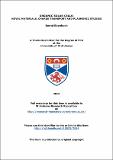Organic solar cells : Novel materials, charge transport and plasmonic studies
Abstract
Organic solar cells have great potential for cost-effective and large area electricity production, but their applicability is limited by the relatively low efficiency. In this dissertation I report investigations of novel materials and the underlying principles of organic solar cells, carried out at the University of St Andrews between 2011 and 2015.
Key results of this investigation:
• The charge carrier mobility of organic semiconductors in the active layer of polymer solar cells has a rather small influence on the power conversion efficiency. Cooling solar cells of the polymer:fullerene blend PTB7:PC₇₁BM from room temperature to 77 K decreased the hole mobility by a factor of thousand but the device efficiency only halved.
• Subphthalocyanine molecules, which are commonly used as electron donor materials in
vacuum-deposited active layers of organic solar cells, can, by a slight structural
modification, also be used as efficient electron acceptor materials in solution-deposited active layers. Additionally these acceptors offer, compared to standard fullerene acceptors,advantages of a stronger light absorption at the peak of the solar spectrum.
• A low band-gap polymer donor material requires a careful selection of the acceptor material in order to achieve efficient charge separation and a maximum open circuit voltage.
• Metal structures in nanometer-size can efficiently enhance the electric field and light absorption in organic semiconductors by plasmonic resonance. The fluorescence of a P3HT polymer film above silver nanowires, separated by PEDOT:PSS, increased by factor of two. This could be clearly assigned to an enhanced absorption as the radiative transition of P3HT was identical beside the nanowires.
• The use of a processing additive in the casting solution for the active layer of organic solar cells of PTB7:PC₇₁BM strongly influences the morphology, which leads not only to an optimum of charge separation but also to optimal charge collection.
Type
Thesis, PhD Doctor of Philosophy
Collections
Except where otherwise noted within the work, this item's licence for re-use is described as Creative Commons Attribution 4.0 International
Items in the St Andrews Research Repository are protected by copyright, with all rights reserved, unless otherwise indicated.


